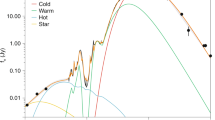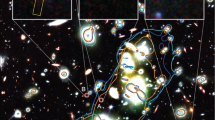Abstract
In the course of checking preliminary lists of IRAS (Infrared Astronomical Satellite) sources to see whether any of the interacting galaxies that we have been studying1 were included, we discovered that the position of the IRAS source 1650+024PO4 (ref. 2) is within a few arc seconds of one of our programme interacting galaxies, NGC6240. Examination of the Palomar sky survey prints shows that NGC6240 is the only non-stellar object within the 1 arc min IRAS error box for this source. Photometry at 10 and 20 µm from the United Kingdom IR Telescope (UKIRT) confirms that this galaxy is among the most luminous IR galaxies yet discovered. An interaction-induced burst of star formation is the most likely source of the strong IR emission.
This is a preview of subscription content, access via your institution
Access options
Subscribe to this journal
Receive 51 print issues and online access
$199.00 per year
only $3.90 per issue
Buy this article
- Purchase on Springer Link
- Instant access to full article PDF
Prices may be subject to local taxes which are calculated during checkout
Similar content being viewed by others
References
Joseph, R. D., Meikle, W. P. S., Robertson, N. A. & Wright, G. S. Mon. Not. R. astr. Soc. 208 (in the press).
Nature 306, 646 (1983).
de Vaucouleurs, G., de Vaucouleurs, A. & Corwin, H. G. Second Reference Catalog of Bright Galaxies, 217 (University of Texas Press, 1976).
Rieke, G. H., Lebofsky, M. J., Thompson, R. I., Low, F. J. & Tokunaga, A. T. Astrophys. J. 238, 24–40 (1980).
Telesco, C. M., Becklin, E. E. & Wynn-Williams, C. G. Astrophys. J. (submitted).
Rieke, G. H. Astrophys. J. 226, 550–558 (1978).
Fosbury, R. A. E. & Wall, J. V. Mon. Not. R. astr. Soc. 189, 79–88 (1979).
Fried, J. W. & Schulz, H. Astr. Astrophys. 118, 166–170 (1983).
Baldwin, J. A., Phillips, M. M. & Terlevich, R. Publ. astr. Soc. Pacif. 93, 5–19 (1979).
Condon, J. J., Condon, M. A., Gisler, G. & Puschell, J. J. Astrophys. J. 252, 102–124 (1982).
Toomre, A. in Evolution of Galaxies and Stellar Populations, (eds Tinsley, B. M. & Larson, R. B.) 401–426 (Yale University Observatory, 1982).
Gehrz, R. D., Sramek, R. A. & Weedman, D. W. Astrophys. J. 267, 551–562 (1983).
Balick, B. & Heckman, T. M. A. Rev. Astr. Astrophys. 20, 431–468 (1982).
Stockton, A. Astrophys. J. 257, 33–39 (1982).
Allen, D. A. Astrophys. J. 207, 367–375 (1976).
Author information
Authors and Affiliations
Rights and permissions
About this article
Cite this article
Wright, G., Joseph, R. & Meikle, W. The ultraluminous interacting galaxy NGC6240. Nature 309, 430–431 (1984). https://doi.org/10.1038/309430a0
Received:
Accepted:
Issue Date:
DOI: https://doi.org/10.1038/309430a0
This article is cited by
-
Star formation and nuclear activity in luminous infrared galaxies: an infrared through radio review
The Astronomy and Astrophysics Review (2021)
-
The origin of the near-IR line emission from molecular, low and high ionization gas in the inner kiloparsec of NGC 6240
Astrophysics and Space Science (2016)
-
Continuum radiation from active galactic nuclei
The Astronomy and Astrophysics Review (1990)
-
cD galaxies of apparent supergiant sizes due to the curvature of space
Astrophysics and Space Science (1986)
-
IR observations of the peculiar galaxy Arp220
Nature (1984)
Comments
By submitting a comment you agree to abide by our Terms and Community Guidelines. If you find something abusive or that does not comply with our terms or guidelines please flag it as inappropriate.



